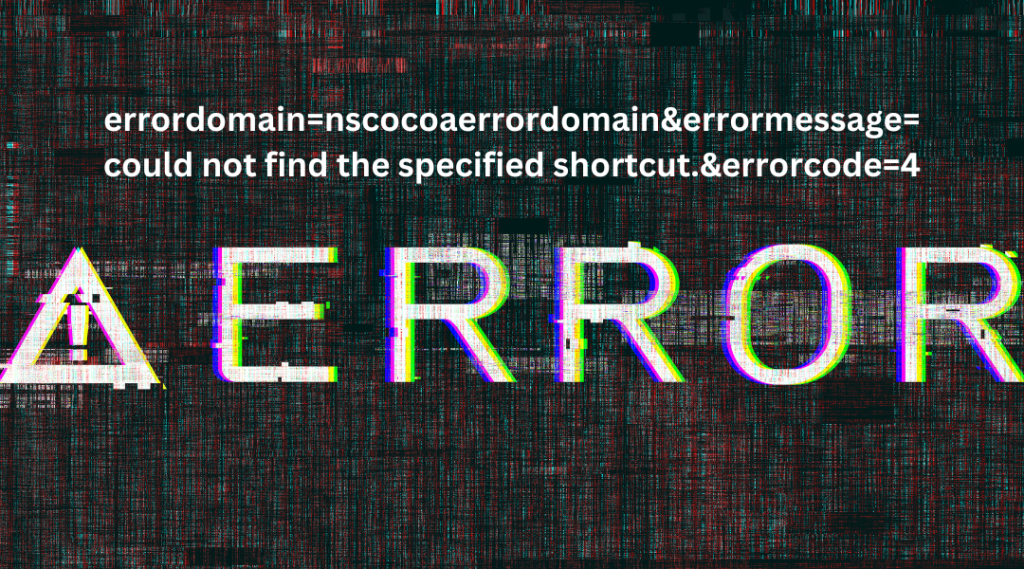errordomain=nscocoaerrordomain&errormessage=could not find the specified shortcut.&errorcode=4
Error messages play a crucial role in software development, serving as a means of communication between the system and developers. When working with Cocoa, Apple’s application development framework, encountering errors is not uncommon. In this exploration, we’ll delve into a specific error message: errordomain=nscocoaerrordomain&errormessage=could not find the specified shortcut.&errorcode=4. We’ll dissect each component, understand its significance, and explore potential solutions.
The Basics of NSError and NSCocoaErrorDomain
In Cocoa, errors are often represented using the NSError class, a part of the Foundation framework. The NSError class encapsulates information about an error, including an error domain, code, and user-info dictionary. The error domain specifies the source or nature of the error, and NSCocoaErrorDomain is a specific domain related to Cocoa framework errors.
Error Domain: NSCocoaErrorDomain
The NSCocoaErrorDomain primarily deals with errors related to Cocoa frameworks and their interactions. When you encounter an error with this domain, it indicates a problem within the Cocoa environment.
Decoding the Error Message
Let’s break down the error message into its key components:
- errordomain=nscocoaerrordomain
- errormessage=could not find the specified shortcut.
- errorcode=4
Error Domain Identification
The presence of errordomain=nscocoaerrordomain signifies that the error originates from the Cocoa framework. This information guides developers to focus on Cocoa-specific troubleshooting strategies.
Understanding the Error Message
The message could not find the specified shortcut. provides a contextual clue regarding the nature of the error. It suggests that the system encountered difficulty locating a designated shortcut. This could be related to user-defined shortcuts or system-assigned key combinations.
Digging Deeper into ErrorCode 4
The numeric code associated with the error is errorcode=4. This code acts as a unique identifier for the specific error instance within the NSCocoaErrorDomain. Understanding the meaning of this code is crucial for devising an appropriate solution.
ErrorCode 4: Unraveling its Significance
In Cocoa error handling, the error codes convey specific information about the nature of the error. ErrorCode 4 could indicate various scenarios:
- Resource Not Found: The specified shortcut, possibly a file or resource, could not be located.
- Permission Issues: The user or application may lack the necessary permissions to access or utilize the shortcut.
- Configuration Error: The shortcut might not be correctly configured in the system or application settings.
Troubleshooting Strategies
Now that we’ve dissected the error message, let’s explore potential strategies for resolving the issue.
Possible Solutions
1. Verify Shortcut Configuration
Begin by reviewing the configuration of the specified shortcut. If the error stems from a misconfiguration, correcting the settings may resolve the issue. Check both user-defined and system-assigned shortcuts to ensure accuracy.
2. Check Resource Availability
If the error pertains to a missing resource, verify the existence and accessibility of the specified shortcut. Ensure that files or resources associated with the shortcut are present and accessible to the application.
3. Permissions and Authorization
ErrorCode 4 could indicate a permissions problem. Ensure that the user or application has the necessary permissions to access and utilize the shortcut. Permissions can be checked both at the file system level and within the application.
4. Debugging with NSCocoaErrorDomain
Leverage the power of NSCocoaErrorDomain by utilizing debugging tools provided by Cocoa frameworks. Instruments such as Xcode’s debugger can assist in tracing the error’s origin and understanding the runtime environment.
5. Consult Apple Documentation and Community Resources
Explore Apple’s official documentation for Cocoa frameworks, especially sections related to NSCocoaErrorDomain and associated error codes. Community forums and discussions can also provide valuable insights and solutions from developers who may have encountered similar issues.
Case Study: Resolving ErrorCode 4 in a macOS Application
Let’s walk through a hypothetical scenario where a macOS application encounters the described error. The application relies on a custom keyboard shortcut (Cmd+Shift+A), and users report that it’s not functioning.
- Verification of Shortcut Configuration
- Navigate to the application’s settings and check the configured shortcut for the intended action.
- Ensure that the specified shortcut matches user expectations.
- Checking Resource Availability
- Confirm that the feature associated with the shortcut is implemented and functional.
- Check for any missing resources or dependencies required for the shortcut to work.
- Permissions and Authorization
- Review the application’s permissions and make sure it has the necessary privileges to access system resources.
- Check if the user has granted the required permissions for the application.
- Debugging with NSCocoaErrorDomain
- Utilize Xcode’s debugging tools to set breakpoints and inspect the flow of execution.
- Examine the error object associated with the NSCocoaErrorDomain to gather additional information.
- Consult Apple Documentation and Community Resources
- Refer to Apple’s documentation for NSCocoaErrorDomain and explore potential solutions or insights.
- Participate in relevant community forums to seek advice from experienced developers.
Best Practices for Error Handling in Cocoa
Understanding and effectively handling errors is integral to robust application development. Consider the following best practices:
1. Graceful Degradation
Implement fallback mechanisms or alternative pathways for critical features. This ensures that, even in the presence of errors, the application can maintain a certain level of functionality.
2. Logging and Monitoring
Integrate comprehensive logging mechanisms to capture error details during development and testing phases. Implement monitoring solutions to track errors in production environments, facilitating prompt identification and resolution.
3. User-Friendly Error Messages
Craft error messages that provide meaningful information to end-users without exposing sensitive details. Clear and concise messages enhance user experience and facilitate quicker issue resolution.
Conclusion
In this exploration of the error message errordomain=nscocoaerrordomain&errormessage=could not find the specified shortcut.&errorcode=4, we’ve gained insights into the components of Cocoa error handling. By dissecting the error domain, message, and code, we can approach error resolution systematically.
Effective error handling is a critical aspect of software development, contributing to the overall reliability and user satisfaction of an application. Whether resolving ErrorCode 4 or addressing other Cocoa-related errors, developers can leverage debugging tools, community resources, and best practices to enhance their error-handling capabilities.

